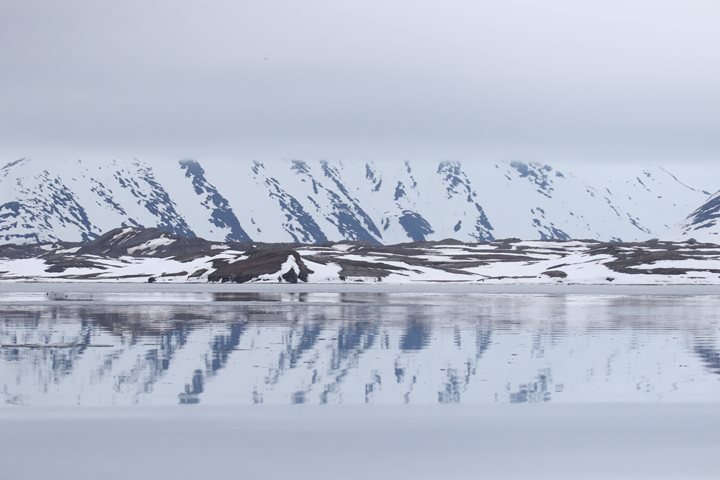Today was our first full day aboard the National Geographic Explorer and the Arctic did not disappoint. Clear skies were present in the early hours of the morning and several guests made their way to the deck to preview the day; others stayed cozy in their cabins awaiting expedition leader Brent’s 07:15 wake-up call.
After breakfast, we headed for the lounge, where we had that opportunity to meet the expedition team and get acquainted with how to proceed up in the Arctic. Immediately afterwards, we went down to the mudroom to have our outer layers and rucksacks decontaminated to minimize the introduction of invasive species to these environments.
Before lunch, we sailed into Krossfjorden, stopping at the base of the majestic Lilliehöökbreen Glacier where we spotted a juvenile walrus perched on a small iceberg as well as several seals. Not wanting to frighten the
During lunch, the ship sailed east into 14th of July Bay, and after enjoying lunch and each other’s company, we headed out on our first expeditions. A few headed out for a medium-length or longer hike to view the entire landscape while most guests opted for a Zodiac tour of the fjord. Over the hour, we were treated to many wildlife sightings, including a mischievous arctic fox chasing barnacle geese and a small herd of grazing reindeer. There were nesting kittiwakes on the cliffs whose calls echoed off the cliff walls, and, as we zigzagged across the bay, we spotted black guillemots and glaucous gulls resting on icebergs. King and common eider ducks took flight all around us; the males’ colorful heads stood out against the blue and white glacier and the water. A highlight of the expedition was a close encounter with a bearded seal posing on sea ice. We continued onward toward the mouth of the bay, where Brünnich’s guillemots and Atlantic puffins could be seen at their nesting sites on the cliffsides. Above the cliffs, barnacle and pink-footed geese grazed on the plants. In a couple of places, we saw some spots of purple saxifrage in bloom. Another striking aspect on the towering cliffs was the bright-orange ornithocoprophyllic lichens. These lichens grow close to bird cliffs and benefit from the particles of airborne bird guano, which is why they’re called birdpooplovinglichens.
After dinner we entered Smeerenburgfjorden, an area with a rich history dating back centuries. Whalers and hunters were the first to come here, followed by adventurers trying to reach the North Pole with hot air balloons. Overnight we will sail across the top of the archipelago and cross 80˚N for the first time. Due to decreased sea ice, it’s possible to cross this line of latitudinal significance very early in the season. Tomorrow morning, we’ll awaken to the sights of the Hinlopen Strait. We went to bed glad to get a few hours rest in bright daylight.








